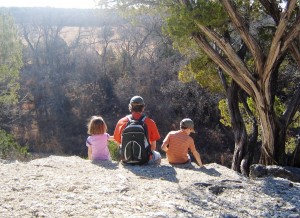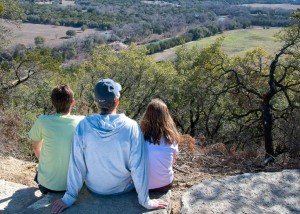by Kelly Pigott
Take a look at these two pictures.
My wife snapped them at the same spot in Dinosaur Valley State Park in Texas about six years apart. Aside from the obvious size differences in my children, you’ll notice the baby fat on my son’s arms has disappeared, replaced with lean muscles from playing mega hours of tennis. My daughter’s cherubic figure has been replaced with that of a young girl. And my hair looks decidedly, um, lighter.
Moments like these remind me of the relentless motion of time. And the constant battle I have to wage against our modern era’s unhealthy view that time is a commodity. That it’s the enemy. Or that it must be strictly managed in order that we can be more productive.
These notions lead us to the same mistake that some of the ancient Jews made with the concept of the Sabbath during the fleeting days of Jesus. They spent an inordinate amount of time arguing about Sabbath laws: how much weight one can carry, how far one can travel, or whether or not starting a fire was technically “work.” But by failing to practice the “spirit” of the Sabbath—to stop and be still—they blinded themselves to the fact that the Lord of the Sabbath was standing right in front of them.
Contemplatives have long pondered the notion of time, and in particular, our unhealthy obsession with either the past or the future. One of them was a 14th century anonymous monk in England who wrote the Cloud of Unknowing. Just about every book written on contemplative spirituality since owes a great debt to this sage, for his wisdom has been passed on from one generation to the next through such stalwarts as John of the Cross, Ignatius, and Teresa of Avila, to name a few.
It’s important to note, too, that this monk lived in England during a time when life was not good. His nation was in the middle of a bitter campaign against France known as the Hundred Years’ War. And plagues swept through the region in giant waves, completely decimating entire towns.
And yet, he had the presence of mind to guide his young novitiates through the disease, violence, and chaos of his age with wisdom like this, “Time is made for us; we’re not made for time.” He goes on to explain, “God, the giver of time, never gives us two moments simultaneously; instead, he gives them to us one after another. We never get the future. We only get the present moment.”
My guess is that this was a tough lesson for the new monks. It must have been hard to relish the moment while you were hauling diseased bodies to the massive open graves. And yet, somehow this 14th century monk learned to do it.
Our world is much different than it was in the 14th century. Or even the first. And yet, in some ways it is the same. We may not argue about Sabbath laws anymore, but my guess is that if Jesus appeared in front of us today, we might miss him because we were gazing at yet another cat picture on Instagram.
And we may not be haunted by plagues, but the memories of mistakes we’ve made can still conjure guilt and shame and remorse. Or a trauma from our past can still bring to the surface the hurt and the anger and the feeling of injustice we experienced. Consequently, we walk around for the rest of the day feeling sick.
“Time is made for us,” the author of the Cloud of Unknowing admonishes. Sounds good. But how do we put that into practice?
One way is to recover the ancient Christian practice of living in the now. Or as I like to put it, to make time stand still. Because what’s all around you at this very moment is simple, beautiful, and profound. But you have to make the effort to notice it.
You have to stop.
Breathe deeply.
And become aware.
Allow the drive to always be elsewhere pass you by.
Answer the voices in your head that call to you from the past or the future with, “What I have is this moment, and this moment is good.”
And give your brain permission to stop filtering out the mundane, and instead, to give priority to it.
I know it’s a bit of a cliché, but as my son and daughter snuggled next to me at the state park I pondered how quickly they had grown. It seems just a little while ago I was rocking them to sleep at night.
My son interrupted my thoughts. “Can we go now?”
“Not yet. Give me a moment,” I said. I inhaled deeply. Juniper. I sensed my children jiggling next to me. Impatient. I saw a vulture floating effortlessly on wind currents scanning for food. I heard the steady trickle from the Paluxy River in front of me, and the shutter clicks from my wife’s camera from behind. My son studied a flat rock and placed it in his pocket, probably to skip across the water later in the day. A breeze pushed my daughter’s hair back, and caused branches to sway back and forth to some ancient rhythm that still echoed in this canyon.
And…time…stood….
Kelly Pigott is the University Chaplain and Associate Professor of Church History at Hardin-Simmons University in Abilene, Texas, where in addition to church history, he teaches courses in ministry and spiritual formation. He has written numerous journal articles and serves on the editorial boards of two academic history societies. He has twenty years of experience as a pastor. Most recently, he contributed a chapter to the book, “Phyllis Tickle: Evangelist of the Future”(Paraclete Press) edited by Tony Jones.
He has a weakness for peanut butter and jelly sandwiches and cheeseburgers. He likes to take long hikes in the mountains, roast marshmallows over a fire, skip stones across a lake, and camp in his trailer with his children Nathaniel and Eliana. He feels most like a kid when he rides his bike around the park. He is very much in love with his wife, Susan, who teaches Old Testament and Hebrew. And he wishes that Mark Twain had written one of the gospels.
Follow Kelly on twitter at @kellypigott

